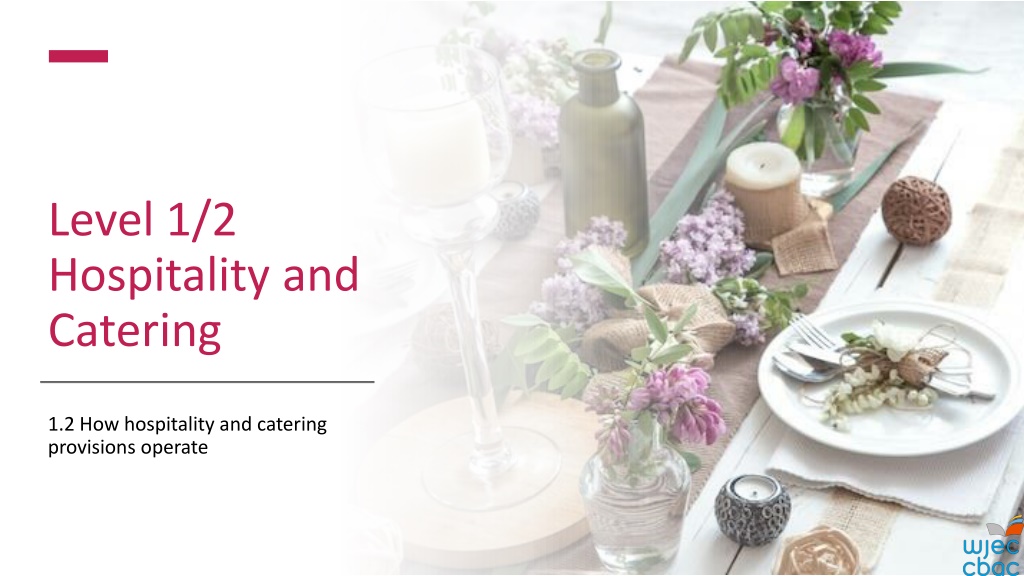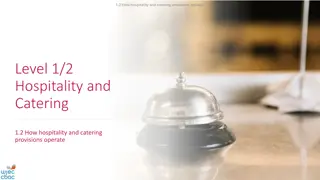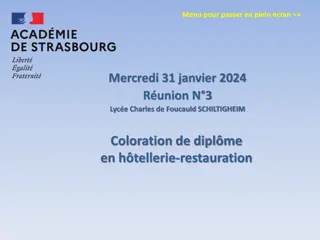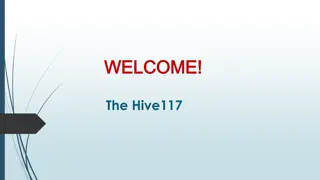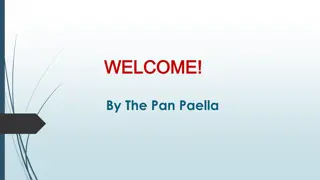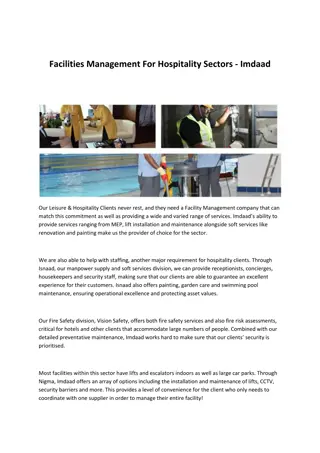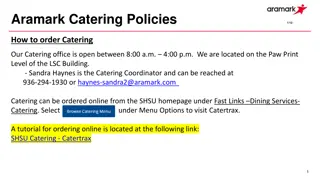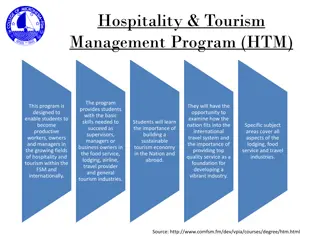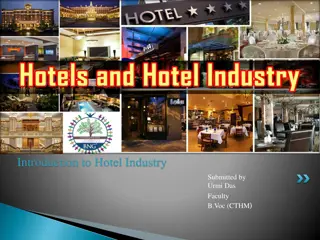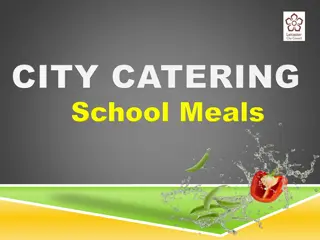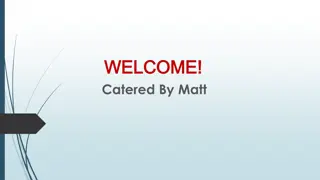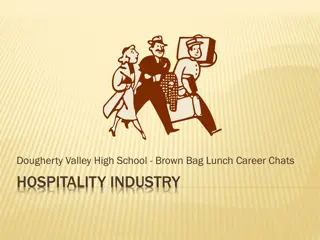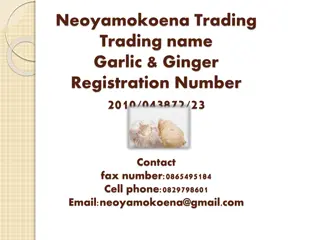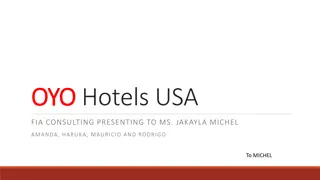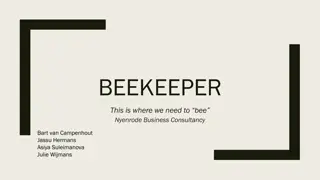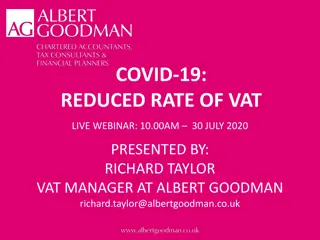Understanding Front and Back of House Operations in Hospitality and Catering
Learn how front and back of house operations play a crucial role in the hospitality and catering industry. Explore the workflow, equipment usage, safety measures, and communication required for efficient customer service. Discover the importance of seamless coordination between front and back of house areas to provide a memorable dining experience.
Download Presentation

Please find below an Image/Link to download the presentation.
The content on the website is provided AS IS for your information and personal use only. It may not be sold, licensed, or shared on other websites without obtaining consent from the author. Download presentation by click this link. If you encounter any issues during the download, it is possible that the publisher has removed the file from their server.
E N D
Presentation Transcript
Level 1/2 Hospitality and Catering 1.2 How hospitality and catering provisions operate
1.2.1 The operation of the front and back of house In this topic, learners will gain knowledge and understanding of the following areas: workflow of the front of house workflow of the catering kitchen large equipment materials for cleaning, first aid kit and safety materials small equipment utensils documentation and administration dress code requirements for front and back of house. 1.2 How hospitality and catering provisions operate
1.2.1 The operation of the front and back of house Front of house Front of house refers to the areas customers can visit within a provision, including the reception, lounge, bar, toilets and serving areas. Managing the front of house workflow is an essential part of the customer experience. If the front of house workflow does not work, the experience for the customer can suffer. Seating area Reception area Waiting area or bar 1.2 How hospitality and catering provisions operate
1.2.1 The operation of the front and back of house Front of house Take the customers to the table or if it is busy, take them to the bar to wait for a table. Clear dishes from the table and give customers the dessert menu. Take the customers to their table and give them the menu. ACTIVITY .. Complete the front of house flowchart for a restaurant by placing the instructions into the correct order. Collect payments from the customers. Serve drinks and take food order. START Serve dessert and tea/coffee. 1 2 3 4 Greet and welcome the customers in the reception area. Clear the table and give the bill to the customers. Take the drinks order and discuss the specials menu. 6 8 7 5 Clear the table, wipe it clean and set it up ready for the next customer. Serve the meals and ask the customers if they need any condiments or anything else. Talk to the customers to make sure they are satisfied with the meal and the service. 10 11 9 12 END 1.2 How hospitality and catering provisions operate
Staff area Service area Storage area 1.2.1 The operation of the front and back of house 1.2.1 The operation of the front and back of house The back of house area is located behind the scenes and is where most of the preparation will take place. Normally, the customers will not see these areas. In order for provision to succeed, the back of house must run smoothly and safely; back of house and front of house need to communicate effectively in order to meet customer needs. All back of house layouts will have a staffing area and toilet facilities for employees to use. A locker should be provided for the staff to be able to store their personal belongings safely. Preparation and cooking area 1.2 How hospitality and catering provisions operate Wash and clean area
1.2.1 The operation of the front and back of house Back of house ACTIVITY Complete the back of house flowchart for a restaurant by placing the back of house areas in order of use. START Handwashing area 2 2 3 3 4 4 1 1 Cooking area Waste area Storage area 5 5 Preparation area 6 6 7 7 Wash and clean area Food serving area 8 8 END Delivery area 1.2 How hospitality and catering provisions operate
1.2.1 The operation of the front and back of house START Back of house 3 3 2 2 4 4 Storage area Handwashing area Preparation area Delivery area 1 1 An area that all deliveries come to first. They are checked and put away. ACTIVITY . Complete the flowchart by writing an instruction for each of the back of house areas. The first one has been completed for you. 5 5 Wash and clean area 6 6 Food serving area Waste area 7 7 Cooking area 8 8 END 1.2 How hospitality and catering provisions operate
1.2.1 The operation of the front and back of house Equipment and materials required, used and managed within catering provision/kitchen Large equipment Industrial equipment is used in large hospitality and catering provisions because it is designed for higher volumes of use and is more robust than domestic equipment. 1.2 How hospitality and catering provisions operate
1.2.1 The operation of the front and back of house 2 1 3 4 Equipment and materials required, used and managed within the catering provision/kitchen Industrial conventional oven Plate warmer Water urn Bain-marie Large equipment 6 8 7 5 Floor/free standing mixer Glass washer Glass chiller Deep fat fryer 10 11 9 ACTIVITY . Identify the names of the large equipment commonly used in the catering kitchen. Walk-in fridge/freezer Pass-through dishwasher Hot plates 1.2 How hospitality and catering provisions operate
1.2.1 The operation of the front and back of house 2 1 3 4 Equipment and materials required, used and managed within the catering provision/kitchen Industrial conventional oven Plate warmer Water urn Bain-marie Large equipment 6 8 7 5 Floor/free standing mixer Glass washer Glass chiller Deep fat fryer 10 11 9 ACTIVITY . Walk-in fridge freezer Pass-through dishwasher Hot plates Research on the internet to find out what each piece of equipment is used for, and the health and safety rules that would apply when using each piece of equipment. 1.2 How hospitality and catering provisions operate
1.2.1 The operation of the front and back of house Equipment and materials required, used and managed within the catering provision/kitchen Large equipment Use Used to heat plates to keep the food hot while serving. Health and safety points Do not overfill the plate warmer. Any object dropped into the dispenser should be removed immediately. The plate warmer should be maintained in safe working order and checked on a regular basis. Only plates of the same diameter should be placed in the warmer. Set the thermostat to a safe working temperature to reduce burns and the risk of damage to the plates. The plates should be removed from the plate warmer one at a time. Plate warmer 1.2 How hospitality and catering provisions operate
1.2.1 The operation of the front and back of house Equipment and materials required, used and managed within the catering provision/kitchen Large equipment Use Used to keep water hot. Health and safety points Do not touch the metal parts of the urn as they will be hot when the urn is in use. Be mindful of the hot steam coming from the lid vents. Do not leave electrical devices unattended when they are in use. You should always place the urn on a clean and level surface. You should always switch off and disconnect the urn from the mains before cleaning or when not in use. NEVER attempt to move the urn when it is full. NEVER OVERFILL THE URN. Water urn 1.2 How hospitality and catering provisions operate
1.2.1 The operation of the front and back of house Equipment and materials required, used and managed within the catering provision/kitchen Large equipment Use Used to keep food hot and ready for serving. Health and safety points Do not touch the metal parts of the bain-marie as they will be hot during use. Use oven gloves to lift the lids. Do not leave electrical devices unattended when they are in use. You should always switch off and disconnect the bain- marie from the mains before cleaning or when not in use. Do not allow to boil dry. NEVER OVERFILL THE BAIN-MARIE. Bain-marie 1.2 How hospitality and catering provisions operate
1.2.1 The operation of the front and back of house Equipment and materials required, used and managed within the catering provision/kitchen Large equipment Use Used to cook a variety of foods on a large scale. Health and safety points You should always use oven gloves. Do not leave electrical devices unattended when they are in use. You should always switch off and disconnect the oven from the mains before cleaning or when not in use. Stand back when opening the doors. Industrial conventional oven 1.2 How hospitality and catering provisions operate
1.2.1 The operation of the front and back of house Equipment and materials required, used and managed within the catering provision/kitchen Large equipment Use Used to deep fry large quantities of food. Health and safety points Do not overfill with oil. Never overload with food. Keep water away from fryers containing hot oil. Lower the basket gently into the oil. Never heat it to a temperature above 200 c as the oil is likely to burn and eventually ignite. Wipe the spillages immediately. You should turn it off after use. Deep fat fryer 1.2 How hospitality and catering provisions operate
1.2.1 The operation of the front and back of house Equipment and materials required, used and managed within the catering provision/kitchen Large equipment Use Used to display chilled food items/beverages. Health and safety points Place the appliance on a clean, level floor. Do not use this appliance except for its intended use. Do not put your fingers/unsuitable items into any holes. This appliance should only be used with the voltage indicated on the cabinet rating label. Use extreme caution when moving or transporting it. Glass chiller 1.2 How hospitality and catering provisions operate
1.2.1 The operation of the front and back of house Equipment and materials required, used and managed within the catering provision/kitchen Large equipment Use Used for mixing and whisking helps with food preparation. Health and safety points Place the appliance on a clean, level floor. Never wear loose clothing, jewellery or hairstyles that may get caught in mixer. Do not put your hand or anything other than the mixture into the drum or tank when it is rotating. Make sure any mixing drums, pots or tanks are secure or have lockable wheels that are securely locked. Floor/free standing mixer 1.2 How hospitality and catering provisions operate
1.2.1 The operation of the front and back of house Equipment and materials required, used and managed within the catering provision/kitchen Large equipment Use Used to wash and rinse large quantities of glasses quickly and efficiently. Health and safety points Glass washer Make sure the glasses are properly placed in the racks. Use the glass rack provided. You should always place the glasses upside down. Place the appliance on a clean, level floor. Be careful when emptying as the glasses may be HOT. Stand back when opening it. 1.2 How hospitality and catering provisions operate
1.2.1 The operation of the front and back of house Equipment and materials required, used and managed within the catering provision/kitchen Large equipment Use Used to wash and rinse large quantities of dishes quickly and efficiently. Health and safety points Pass-through dishwasher Place sharp items, such as knives, with the sharp points facing downwards in the utensil basket. Place glass items carefully to prevent them from breaking/chipping. Avoid overloading the dishwasher. Allow the machine to cool before reaching into it to prevent burns from the steam. 1.2 how hospitality and catering provisions operate
1.2.1 The operation of the front and back of house Equipment and materials required, used and managed within the catering provision/kitchen Large equipment Use Used to store large quantities of food at a safe temperature. Health and safety points Keep the walk-in unit clean. Check the safety release device on the doors regularly. Do not overload the shelves. Offer workers jackets, hats and gloves when they use the walk-in unit. Walk-in fridge/freezer 1.2 How hospitality and catering provisions operate
1.2.1 The operation of the front and back of house Equipment and materials required, used and managed within the catering provision/kitchen Large equipment Use Used to cook large quantiles of different food, such as burgers and vegetables. Health and safety points Hot plate You should avoid spilling water on the surface. Cool the hot plates before cleaning them. Dry with a cloth. Keep your hands and clothes away from the hot plate. You should turn it off after use. Never leave the grill unattended. Use the correct temperature settings. Make sure that the grill pan is clean before use. 1.2 How hospitality and catering provisions operate
1.2.1 The operation of the front and back of house Equipment and materials required, used and managed within the catering provision/kitchen Small equipment Small equipment is used in smaller provisions, such as coffee shops and cafes. The equipment is usually designed to fit tight spaces. 1.2 How hospitality and catering provisions operate
1.2.1 The operation of the front and back of house Equipment and materials Equipment and materials required, used and managed required, used and managed within the catering within the catering provision/kitchen provision/kitchen 2 1 3 4 Blender Tabletop mixer Mincer Food processor Small equipment 8 6 5 7 ACTIVITY . Identify the names of the small equipment that are often used in the catering kitchen. Rice cooker Hand blender Ice cream maker Coffee grinder Create a PowerPoint presentation suitable to be given to a trainee chef which explains the use of small equipment often used in the kitchen and the associated health and safety rules. 10 9 12 11 Vacuum seal Sous vide Microwave Steamer 1.2 How hospitality and catering provisions operate
1.2.1 The operation of the front and back of house Equipment and materials required, used and managed within the catering provision/kitchen Cleaning and safety materials 1.2 How hospitality and catering provisions operate
ACTIVITY .. .. Think about the different items you would expect a first aid box to contain. Plasters Emergency contact information Gauze roll and pads Elastic bandages First aid manual Triangular bandage Thermometer Adhesive tape Safety pins Tweezers Instant cold pack Scissors Antiseptic wipes Gloves Emergency blanket 1.2 How hospitality and catering provisions operate
1.2.1 The operation of the front and back of house Documentation and administration requirements used in a catering kitchen Keeping documents is important for business success as this helps maintain good organisation, employee and customer safety, and ensures bills are paid on time. Documents should be easy to read, filled out correctly and signed and dated. Keeping certain documentation, for example gas safety certificate, fire safety certificate and accident reports is a legal requirement. 1.2 How hospitality and catering provisions operate
1.2.1 The operation of the front and back of house Documentation and administration requirements used in a catering kitchen Stock control systems (first in, first out) system should be used by every provision in order to use stock efficiently. 1.2 How hospitality and catering provisions operate
1.2.1 The operation of the front and back of house Documentation and administration requirements used in a catering kitchen Ordering A point of sale (PoS) system can be used to order and pay for products. There are a variety of ordering systems available; popular ones include a mobile point of sale where the server can take an order or payment on a digital device, card readers, touch screens, smartphones and tablets. 1.2 How hospitality and catering provisions operate
1.2.1 The operation of the front and back of house Documentation and administration requirements used in a catering kitchen Delivery notes A delivery note is a document that lists all the products that have been ordered. Every provision will compare the items that have been delivered against the delivery note to make sure that each item has been delivered correctly. If any items are incorrect, the provision will need to contact customer services to resolve the issue. 1.2 How hospitality and catering provisions operate
1.2.1 The operation of the front and back of house Documentation and administration requirements used in a catering kitchen Invoices Health and safety documentation Risk assessments and accident documentation must be kept by law. 1.2 How hospitality and catering provisions operate
1.2.1 The operation of the front and back of house Documentation and administration requirements used in a catering kitchen Food safety documentation Hazard analysis and critical control point (HACCP) and risk assessment documentation are legal requirements for all catering provisions. All employees food hygiene certificates should be recorded and kept, as well as monitoring documentation in relation to stock rotation and temperature control. 1.2 How hospitality and catering provisions operate
1.2.1 The operation of the front and back of house Typical dress code for the front and back of house Chef/cook dress code In the hospitality and catering industry, a dress code is followed for front and back of house workers. ACTIVITY .. Chef s hat Label the template using the typical dress code for a chef/cook. The hat is called a toque blanche. It allows heat to circulate, keeping the chef's head cool. Justify why the chef should wear each item. The first one has been completed for you. 1.2 How hospitality and catering provisions operate
Chefs hat The hat is called a toque blanche. It allows heat to circulate, keeping the chef's head cool. 1.2 How hospitality and catering provisions operate
Hair and beard nets They are worn to protect the food from physical contamination. Chef s hat The hat is called a toque blanche. It allows heat to circulate, keeping the chef's head cool. Apron An apron is tied in the front, and the upper part of the apron is rolled over so that it can be removed easily and prevent it from catching fire. Aprons are worn up to the knee to protect the lower part of the body from spillages and heat. Chef whites and aprons protect the food from physical contamination. A chef s whites offers additional protection against heat, scalding and spills. Double-breasted jacket With knotted cloth buttons or poppers, which help to remove the whites in an emergency. Non-slip shoes The shoes are designed to be comfortable and to protect the feet from spillages and sharp objects. Chef trousers The trousers will usually be loose as there will be less contact with the skin if there is a spillage. Usually, chef trousers have an elastic waist so they can be easily removed in an emergency. 1.2 How hospitality and catering provisions operate
1.2.1 The operation of the front and back of house Typical dress code for the front and back of house Hair tied up To prevent hair from getting into the food. Front of house dress code In the hospitality and catering industry, a dress code is followed for front and back of house workers. ACTIVITY .. Label the template using the typical dress code for a front of house worker. The first one has been completed for you. 1.2 How hospitality and catering provisions operate
Hair tied up To prevent hair from getting into the food. 1.2 How hospitality and catering provisions operate
Hair tied up Bow tie or tie Worn to look smart. To prevent hair from getting into the food. Name tag Clean, white ironed shirt So that customers know the name of their server. Black or white knee length apron Waistcoat Smart trousers With pockets to hold a notepad or bottle opener. Non-slip shoes Black socks or nude/black tights with non-slip black flat shoes. 1.2 How hospitality and catering provisions operate
STARTER/PLENARY ACTIVITY .. ..... Instructions: Read through the answers provided below and decide which question they could be answering. Question Answer 1 Sieve 2 Measuring spoons 3 Ladle 4 Colour-coded chopping boards Grater 5 6 Measuring jug 1.2 How hospitality and catering provisions operate
STARTER/PLENARY ACTIVITY .. ..... Identify the kitchen utensils. 1 4 3 2 Grater Measuring jug Bottle opener Cake slicer 5 8 7 6 Mixing bowl Temperature probe Balloon whisk Measuring spoons 1.2 How hospitality and catering provisions operate
STARTER/PLENARY ACTIVITY .. ..... Identify the kitchen utensils. 4 1 3 2 Sieve Slotted turner Saucepan Slotted spoon 5 8 7 6 Colour-coded chopping boards Ladle Metal tray Wooden spoon 1.2 How hospitality and catering provisions operate
STARTER/PLENARY ACTIVITY .. ..... Identify the kitchen utensils. 4 3 1 2 Casserole dish Tin opener Spatula Knives 8 5 7 6 Kitchen scissors Pastry brush Rolling pin Griddle 1.2 How hospitality and catering provisions operate
1.2 How hospitality and catering provisions operate STARTER/PLENARY ACTIVITY . PAST PAPER QUESTION
1.2 How hospitality and catering provisions operate STARTER/PLENARY ACTIVITY . PAST PAPER QUESTION
1.2 How hospitality and catering provisions operate STARTER/PLENARY ACTIVITY . PAST PAPER QUESTION
1.2 How hospitality and catering provisions operate STARTER/PLENARY ACTIVITY . PAST PAPER QUESTION
1.2 How hospitality and catering provisions operate STARTER/PLENARY ACTIVITY . PAST PAPER QUESTION
1.2 How hospitality and catering provisions operate STARTER/PLENARY ACTIVITY . PAST PAPER QUESTION
1.2 How hospitality and catering provisions operate STARTER/PLENARY ACTIVITY . PAST PAPER QUESTION
Glossary Digital systems Software that allows online booking and ordering. 1.2 How hospitality and catering provisions operate
Glossary Dress code A set of rules about clothing and appearance in a place of work. 1.2 How hospitality and catering provisions operate
